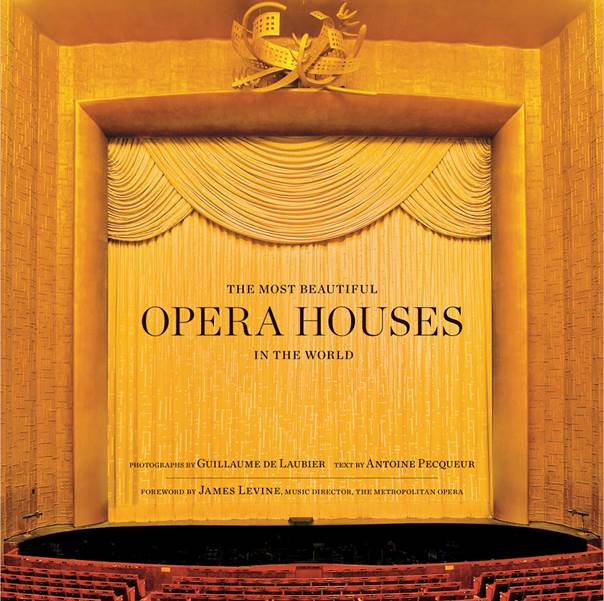
THE MOST BEAUTIFUL OPERA HOUSES IN THE WORLD
Photographs by Guillaume de Laubier, Text by Antoine Pecqueur; Translated from French;
Published by ABRAMS, NYC; www.abramsbooks.com;
239 pages 29x29cms (11.5x11.5 inches); USD $60.00
Click here for more details about the publisher
Click here to order the book on amazon.com

For each of the thirty-one theatres selected there are wonderful façade, auditorium, stage, foyer, and architectural detail photos. Any book of this size and ambition cannot include every beautiful (and great) opera house, and there are some serious omissions. The Met at Lincoln Center and the Chicago Civic are the only USA houses covered; no San Francisco, Houston or Santa Fe; Germany is well covered (Dresden, Essen, Bayreuth and the jewelbox Cuvillies in Munich), but no Berlin, Munich’s Bayerische Staatsoperor or Hamburg. London has both the Royal Opera and the ENO Coliseum; Russia has the Bolshoi, but not the Maryiinsky; Paris obviously has the ornate Garnier, but not the newer Bastille, and only one Spanish opera house made the final selection, nor are we treated to the great theatres of Prague. Alas, no Cólon in Buenos Aires, one of the largest and most glorious theatres in the entire world. But, as I said, not every worthy opera house is included nor could be included in this ambitious work. Choices had to be made to make the book both practical and reasonably priced. The USA $60.00 is a bit steep, but the book can be found online at a lesser price.
The compilers in their effort to present beautiful opera theatres also had the intellectual need to include historically and architecturally significant theatres. Thus we have the Cuvilliés in Munich, the Opera Royal in Versailles, the Teatro Farnese in Parma, the Olimpico in Vincenza, the Théàtre du Chateau de Chimay in Belgium, the Théàtre de la Reine in Versailles, and the Zámacké BaroknÍ Divaldo in Česky Krumlov in the Czech Republic. None of these theatres currently present opera on an international level, although perhaps they occasionally do so at the local level, but not to my knowledge. The newer theatres in Essen, Germany, the Norske Opera in Oslo, the New National in Tokyo and the Palau du Les Arts Reina Sofia in Valencia also earn inclusion, but the famous Sydney, Australia opera house, the iconic symbol of the city, is included but only described, not photographed. Since de Laubier did all the photography himself, one must assume that trips to Australia or to Argentina were not feasible. The little essays that accompany each theatre entry contain some interesting and relevant information, but not particularly insightful about the operatic art form connected to the pictured opera house.
The title of the book is a bit misleading as “most beautiful” is a highly subjective concept. My impression is that the compilers wanted to cover the most opera-important theatres whether they are aesthetically the very best examples. Beauty does not always mean ornate or detailed or just plain old. James Levine, who penned the Forward for this handsome book says that he looks for two things in an opera house over pure beauty, good acoustics and superior facilities – these are likely to insure superior performances, the acoustics for the audience’s benefit and the facilities for the artist’s ability to do their best work.
Even with the questionable “superlative” title of the book (“Most beautiful”), and the choice of theatre inclusions (and omissions) this book is a high quality Abrams art book; lavish and beautifully photographed and printed. It is recommended for aficionados and lovers of superior large photo books.
Charles Mintzer